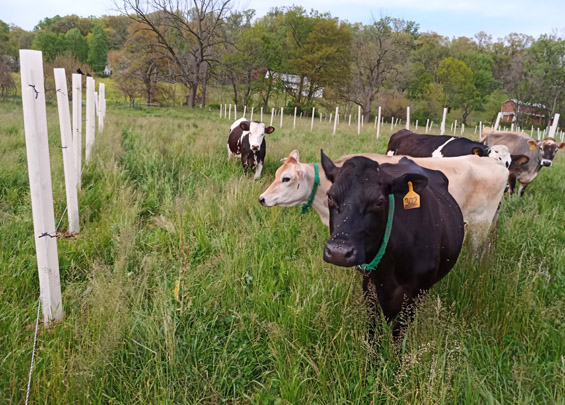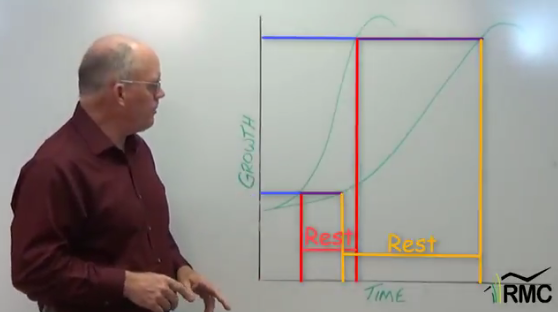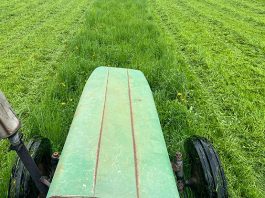If you missed all the important things that trees can do for you and your livestock, check out last week’s article, “Take Your Grazing Up a Level By Adding Trees to Your Pastures.”.

It’s that time of year when everyone has long forgotten the cold of winter and the mild days of spring. The summer heat is fully upon us.
I don’t know about you, but I don’t do so well in the heat. I had the option yesterday of walking around an open pasture in full sun on a humid, 90-degree day, or take it easy in the shade and take a few phone calls. You can bet I parked myself in the shade.
As you well know, it’s no different for livestock. They would much rather stand in a creek or hunker down under a shade tree in the heat of the day than venture out to graze. And while having a tree or two in the paddock is a welcome gift to the livestock, concentrating all that impact and manure in one spot isn’t helping pasture health.
I’ve spent the last two years puzzling and working away at this question of how to get a tree established in an active pasture, with minimal changes to the way that pasture is managed. For the sake of your livestock, pastures and bottom line, I’d like to share what I’ve learned.
The trick in getting a tree established in a pasture, as opposed to your front yard, is of course in how to protect that tree from rubbing, browsing or being knocked over. So far, I’ve found two solutions that have worked. To test them statistically, I am working on a SARE grant with the Chesapeake Bay Foundation, and final results will be available a couple years from now. Yet here’s what I can tell from my experience so far, experience gained from planting several thousand pasture trees, as well as 10,000+ trees outside of pastures and then following up for several years afterwards to see how they do.
The easiest way I’ve found to protect a tree in active pastures is to start with the right tree shelter, specifically a 6’ Plantra SunFlex Growtube system. The reason those have proven best is that they come with a flexible fiberglass stake that holds up well to rubbing from cattle or sheep. If you were to use a tree shelter with a wooden stake, you’d better be prepared to replace stakes every time livestock rotate through.
A shelter alone won’t do it however. You need a way to keep animals from rubbing on the shelter. The two options that are working for us are electric fencing and barbed wire.
If planted in a row, the simplest way to protect that row of trees is to run a single strand of electric fencing between the livestock and trees.

You can use that row of trees as a paddock division, and even use the fiberglass stakes and ties instead of step-in posts.

Installing barbed wire around every tree is more labor intensive and usually exacts some blood as payment. It offers you the flexibility of protecting trees individually when making a row of trees the paddock boundary is not an option. What I’ve found works is taking about 8’ of wire and wrapping it up around the shelter.

Plantra shelters have the added bonus in this case that the fiberglass stake is attached to the shelter by means of three oversized twist ties. Those twist ties are great for attaching barbed wire to the shelter.

Now that keeping the shelter protected from livestock is taken care of, we still need to make sure the tree survives in its new pastoral home. While livestock can claim the life of a seedling, so can rodents and weeds.
To give the tree a good start, the area planted should first get a good site prep. Conventional guides will tell you to use herbicide, but for those who want an organic option, scalping the sod is a good route as well. Then dig a hole about three times larger than you need, which will further break up roots of vegetation that might otherwise compete, while giving nice friable soil for the tree roots to expand into. Once the tree is in the ground and the shelter in place, I like to add a thick (6+ inches) layer of coarse woodchips as a mulch to keep weeds down, discourage voles from burrowing in, and conserve soil moisture.

Those are the practices we commonly use at this point, and we’re always eager to learn how to do things better. A single landscape staple installed opposite the fiberglass stake should help keep the shelter from twisting on a stake, a problem we’ve seen here and there. Also, weeds growing inside the tubes can become a high-maintenance headache. The conventional approach is to drop pre-emergent herbicide granules in, but I would much prefer a natural method. An inch of fine woodchips or shavings inside the tube would likely do the trick, at least giving the tree the head start it needs to get established before other plants do. Getting control of weeds early on will pay huge dividends through stronger growth, less need for weeding, and less need for replanting.
If you’re wondering when to plant, spring and fall (when the tree is dormant) are much better than summer, since you’ll have less worry about watering if the rain clouds stay away for weeks at a time.
So now you know it’s possible to establish a tree in an active pasture, without much change to your grazing practice. I encourage anyone getting into this to start small, planting say 10 trees this fall to get a feel for it, then scale up afterwards. You’ll also want to pick the right set of trees. Any tree will obviously cast shade shade, but some will do that and a whole lot more. The first in this series, “Take Your Grazing Up a Level By Adding Trees to Your Pastures.”
I’ll be writing more on this so stay tuned!





Just curious as to what kind of trees are in the plantings in the photos and what are the spacings within the rows and between the rows?
On the topic of animals camping under shade trees and over -manuring and trampling…is there any solution besides moving the animals to the next paddock before damage is done? Even if there are several trees in a paddock, my sheep will pick a favorite one and all lie there. If there are no trees they still pick a favorite place to lie to ruminate and rest and drop manure ,which occupies many more hours than grazing.
Great questions Emily.
The trees are a mixture of honey locust, black locust, persimmon, hybrid willow, hybrid poplar and mulberry. The honey locust and persimmon are primarily for dropped feed late in the season, black locust for prolific nitrogen fixation, and the others as sources of tree fodder.
The spacing is rather tight in this one. Due to stipulations attached to the funding source, we had to hit 155 trees/acre. Since we used 40′ between rows, that means we need 7′ between trees in the row. Though it’s tight, it can definitely work, since many trees will be pollarded and lower branches will be pruned off others. If there wasn’t a density requirement, I likely would have gone about half as dense.
I wish I could give you a good answer about getting sheep to move more, or spread their impact around evenly. It sounds like they get pretty attached to a spot and have a strong instinct to stick with the flock. One tree-planting option could be to plant trees in clusters, creating a grove that can accommodate the whole flock at once.
I’ve included a link below to a resource on pollarding if you’re interested in learning more.
https://www.mofga.org/Publications/The-Maine-Organic-Farmer-Gardener/Summer-2017/Tree-Leaf-Fodder-for-Livestock
Thank you for encouraging more tree planting in pastures. Great topic. But I couldn’t see any trees! ? Just the white sleeve. How can the tree survive without leaves out in the sun?
Hi Nina,
I should clarify that. There are trees inside each of those tubes, enjoying a little greenhouse effect. They don’t get to spread their branches until they get to the top, but that encourages a nicer growth form.
Tree tubes are pretty much standard practice in tree planting for conservation. Mostly they’re used to keep deer and voles away, and mark where the tree is so we don’t lose it, which is a big problem with small trees in an area of high grass.
For pasture areas, we have to beef up the shelters a bit to withstand rubbing and browsing by much larger animals than deer, but the shelters are what forms the protection around the tree until it matures enough to fend for itself.
Comments are closed.